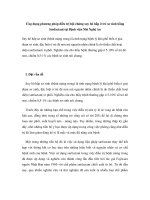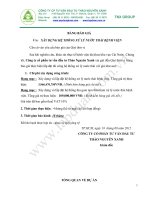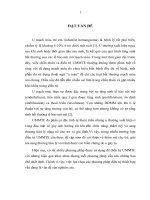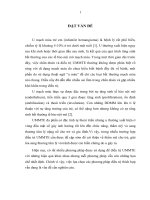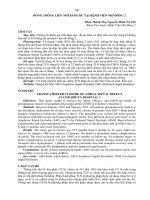ĐÓNG THÔNG LIÊN NHĨ BẰNG dù tại BỆNH VIỆN NHI ĐỒNG 2
Bạn đang xem bản rút gọn của tài liệu. Xem và tải ngay bản đầy đủ của tài liệu tại đây (15.38 MB, 5 trang )
398
NG DÙ TI BNH VIN NG 2
Phan Thành Th, Nguyn Minh Trí Vit
Khoa Tim mch, Bnh Ving 2
:
:
:
tháng dùng cord
:
:
SUMMARY
TRANSCATHETER CLOSURE OF ATRIAL SEPTAL DEFECT
Objectives: This study sought to analyze the safety, efficacy, and follow-up results of
Methods: Between february 2010 and february 2011, 60 patients percutaneously treated at
our institution. Indications for closure were: elective closure in patients with ASD > 8mm and/or
frequent respiratory infections; failure to thrive. The procedure was carried out under general
anesthesia with fluoroscopy and transesophageal control. Two different devices were used: 1) the
Amplatzer Septal Occluder (ASO) and 2) the Oclutech Septal Occluder (OSO). Basal physical
examinations and echocardiograms were performed prior to the procedure and at follow-ups (1,
6, and 12 months, and yearly thereafter).
Results: The mean age at closure was 35,5 months from 6 months to 14 years. ASO was
used in 38 subjects; OSO was used in 22 patients. No death or immediate major complications
occurred. The total occlusion rate was 100% at 6 months of follow-up. No midterm major or
minor complications occurred. 1 patient had chronic hemolytic anemia because mitral valve and
tricuspid valve regurgitation. 1 patient with atrial premature beat had complete recovery after 3
months with cordarone PO. Symptomatic patients improved significantly.
Conclusions: In the current experienced hands, ASD closure can be performed safely and
successfully, even in very young children.
Key words: ASD atrial septal defect; ASO (Amplatzer Septal Occluder); OSO (Occlutech
Septal Occluder).
7
118,3],
399
12
4], [24].
[4,1].
h nhân
2]; 9].
O
Quy trình theo dõi:
60
35,5
32/28
(kg)
12,24 43)
(mm)
8 30
Có 3
400
3.8 ( 3- 5)
27)
-34)
ASO (mm)
-34)
OSO (mm)
10 32
8 - 30
ASO = Amplatzer Septal Ocluder ; OSO = Occluder Septal Ocluder
lúc thông tim.
còn shunt
hoàn toàn.
theo dõi Holter
3.6. Theo dõi
theo dõi có 1 này
(1,6%)
10,18
5,13
4,6,1,21,14
[4,1,21
20
23]
6
Trong quá trình theo
22
401
thông tim: kChúng
11,8,5,13,16,15].
1. Berger F, Ewert P, Bjornstad PG, et al (1999). Transcatheter closure as standard
treatment for most interatrial defects: experience in 200 patients treated with Amplatzer
septal occluder. Cardiol Young. 9:468473
2. Burgio GR (1998). Il bambino con infezioni ricorrenti. Plebani A. Immunologia
Pediatrica. Milan: McGraw Hill Libri Italia. p. 17
3. Butera G, Carminati M, Youssef R, et al (2001). Percutaneous versus surgical closure of
secundum atrial septal defect. Third World Congress of Pediatric Cardiology and
Cardiac Surgery, May 2731, 2001, Toronto, Ontario, Canada. Card Young. 11(Suppl
1):58
4. Carminati M, Chessa M, Butera G, et al (2001). Transcatheter closure of atrial septal
defects with the STARFlex device: early results and follow-up. J Interv Cardiol. 14:319
324
5. Castaneda AR, Jonas RA, Mayer JE, Hanley FL (1993), Atrial septal defect. In: Cardiac
Surgery of the Neonate and Infants. Philadelphia, PA: WB Saunders, pp 143.
6. Chessa M, Carminati M, Butera G, et al (2002). Early and late complications associated
with transcatheter occlusion of secundum atrial septal defect. J Am Coll Cardiol.
39:10611065
7. Dickinson DF, Arnold R, Wilkinson JL (1981). Congenital heart disease among 160,480
liveborn children in Liverpool 1960 to 1969: implications of surgical treatment. Br Heart
J. 46:5562
8. Galal MD, Wobst A, Halees Z, et al (1994). Peri-operative complications following
surgical closure of atrial septal defect type II in 232 patients: a baseline study. Eur Heart
J. 15:13811384
9. Hamil PV, Drizd TA, Johnson CL, Reed RB, Roche AF, Moore WM (1979). Physical
growth: national center for health statistics percentiles. Am J Coll Nutr. 32:607629
10. Helgason H, Jonsdottir G. Spontaneous closure of atrial septal defects. Pediatr Cardiol.
1999;20:195199
11. Horvath KA, Burke RP, Collins JJ Jr, Cohn LM (1992). Surgical treatment of atrial septal
defect: early and long-term results. J Am Coll Cardiol.20:11561159
12. King TD, Thompson SL, Steiner L, Mills NL (1976). Secundum atrial septal defect:
nonoperative closure during cardiac catheterization. JAMA. 235:25062509
13. Kirklin JW, Barrat-Boyes BG (1993). Cardiac Surgery. 2nd edition. New York, NY:
Churchill Livingstone, pp 609
14. Krizanic F, Sievert H, Pfeiffer D, Konorza T, Ferrari M, Figulla HR (2008). Clinical
evaluation of a novel occluder device (Occlutech) for percutaneous transcatheter closure
of patent foramen ovale (PFO). Clin Res Cardiol, 97:872-7.
15. Meijboom F, Hen J, Szatwari A, et al (1993). Long-term follow-up (9 to 20 years) after
surgical closure of atrial septal defect at a young age. Am J Cardiol. 72:14311434
16. Murphy JG, Gersh BJ, Mc Goon MD, et al (1990). Long-term outcome after surgical
repair of isolated atrial septal defect: follow-up at 27 to 32 years. N Engl J Med.
402
323:16451650
17. Newman MF, Kirchner JL, Phelips-Bute B, et al (2001). Longitudinal assessment of
neurocognitive after coronary by-pass surgery. N Engl J Med. 344:3954
18. Radzik D, Davignon A, van Doesburg N, Fournier A, Marchand T, Ducharme G. (1993),
Predictive factors for spontaneous closure of atrial septal defects diagnosed in the first 3
months of life. J Am Coll Cardiol. 22:851853
19. Rao PS, Langhough R, Beekman RH, Lloyd TR, Sideris B (1992). Echocardiographic
estimation of balloon-stretched diameter of secundum atrial septal defect for transcatheter
occlusion. Am Heart J. 124:172175
20. Rastegari M, Redington A, Sullivan ID (2001). Influence of the introduction of
Amplatzer device on the interventional closure of defects within the oval fossa in
children. Cardiol Young. 11:521525
21. Sievert H, Babic UU, Hausdorf G, et al (1998). Transcatheter closure of atrial septal
defect and patent foramen ovale with the ASDOS device: a multi-institutional European
trial. Am J Cardiol. 82:14051413
22. Visconti KJ, Bichell DP, Jonas RA, Newburger JW, Bellinger DC (1999).
Developmental outcome after surgical versus interventional closure of secundum atrial
septal defect in children. Circulation. 100(Suppl II):II145150
23. Vogel M, Berger F, Dahnert I, Ewert P, Lange PE (2001). Treatment of atrial septal
defects in symptomatic children aged less than 2 years of age using the Amplatzer septal
occluder. Cardiol Young. 10:534537
24. Zhong-Dong Du, Hijazi ZM, Kleinman CS, et al (2002). For the Amplatzer Investigators.
Comparison between transcatheter and surgical closure of secundum atrial septal defect
in children and adults. J Am Coll Cardiol. 39:18361844

